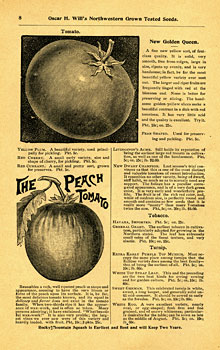
1895 Will catalog page 8 featuring tomato
SHSND# 10190Taste tests proved the Buttercup squash superior to eight other winter squashes. This bulletin included six pages of recipes for Buttercup squash, a highly unusual move for an AES bulletin. (See Appendix C)
In 1933, Yeager published a third bulletin (Bulletin 276, Tomato Breeding) on breeding, this time on tomatoes. His passion was to breed a tomato with more vitamins than the average tomato – a tomato that was “as good as oranges.” He began breeding tomatoes as soon as he arrived in ND and had some success fairly early, but he wasn’t satisfied with the qualities of the early tomatoes such as Agassiz, Red River, and Fargo. In 1929, he succeeded in developing Bison, a tomato which was smooth, large, determinate, and early. It became the leading tomato for northern Great Plains gardens with “exceedingly heavy yields.”
In the course of his eighteen years at NDAC, Yeager conducted research on watermelon, seven kinds of beans, beets, Brussels sprouts, Chinese cabbage, two kinds of carrots, sweet corn, eggplant, ground cherries, honey dew melon, purple podded peas, peppers, rutabagas, buttercup squash, butternut squash, and tomatoes. He was called North Dakota’s Luther Burbank. When he resigned in 1937, editorials in his favor (and against Governor Langer who was probably responsible for Yeager’s discontent) appeared around the state. He ended up at the University of New Hampshire where he continued to work on early vegetable varieties, many of which ended up back in ND gardens. (Danbom, p. 111-112; NDSU Archives Biography, A.F. Yeager)




